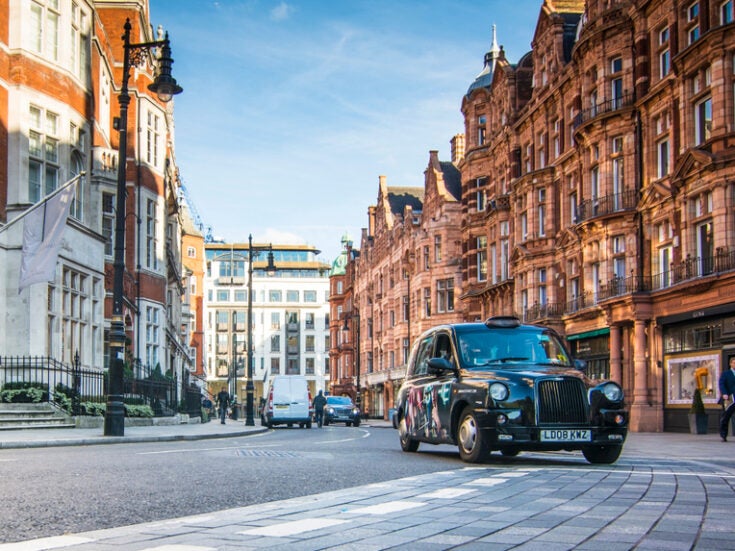Andrei Navrozov on why London is just like an old flame – one that’s bursting into a gigantic fireball.
Andrei Navrozov on why London is just like an old flame – one that’s bursting into a gigantic fireball.
When Cimabue the painter, passing on the road to Bologna, saw, as he walked through the village of Vespignano, a boy called Giotto drawing a sheep on a flat piece of rock, this was the moment with which, more than a century later, Lorenzo Ghiberti, the sculptor and the first art historian of the Renaissance, began his Commentaries.
And so I, in London on the briefest of sojourns, with the wistfulness of an exile who longs for a glimpse of his homestead even if it should cost him his life, witnessed a scene that represents modern sensibility as the crouching form of young Giotto signalled the Renaissance.
A young woman wearing vampire heels, which, history records, were part of the new season’s Miu Miu collection, had clambered aboard the number eleven bus bound for St Paul’s and was rummaging in her handbag to find her ticket, when the driver, by opening the doors at a bus stop, caught the woman’s shoe in one of them. In the space of a gasp the shiny stiletto held the bus hostage, recalling the voluminous crinoline that dominated the life of Baudelaire in Manet’s portrait of the poet’s mistress.
Clearly the driver, an older man, had been cognisant of the woman’s charms, which culminated, as it were, in the acumination now in peril. Instinctively, he shut the doors, very nearly maiming the first in the crowd of passengers who had begun boarding. And thus, in a city of smouldering class prejudice and suppressed political resentment, obsessed with bombs and security, with never smoking and hardly ever swearing, with sexual harassment and political correctness of every conceivable kind, what I witnessed was a characteristic instantané from the fetish art of Eric Stanton.
One need not bone up on Vasari or peruse Ghiberti to be reminded of the monumentality of the social role reserved in Europe for the fine arts until well into the last century. ‘Si monumentum requiris,’ famously runs Sir Christopher Wren’s epitaph in the Cathedral’s crypt, ‘circumspice,’ and one look out of a corner of the Millennium Eye will persuade the visitor that London, like all the great effigies of European civilisation, is indeed part of the same aesthetic tradition that has raised Rome and Paris, the tradition that has given Europe a habitation and a Christian name.
Today that selfsame social role is played by the art of adorning women, by make-up, hairdressing and dressmaking, by the cosmetics industry and the incalculable myriad enterprises that, like the artists’ workshops of old, strive to elevate their craft to a position of predominance. I had come back from exile thinking that, if there was nothing about London to envy, at least I could envy its marmoreal coolness. What I found was the boudoir of a Hollywood starlet on the brink of hysterical self-immolation.
At times the self-immolation was reminiscent of Hogarth’s progress and their modern analogues by Adam Dant, in whose Hell in Berkeley Square a sinner is broiled in brimstone on the bonnet of a Rolls-Royce.
‘Singular society, where everyone earns money or is ruined!’ noted the Goncourts in their Journal. ‘Never have appearances been so imperious, so dominating, so damaging and demoralising.’ At the height of the epoch that supplanted the aristocracy of class with that of money, Baudelaire was among the first to argue that ‘elle doit se dorer pour être adorée,’ that if a woman is to be adored, she must be adorned.
For beauty is not a natural gift, but the product of reason and calculation, and only in making herself appear ‘magical and supernatural’ with cosmetics and costumes, perfumes and jewels, does a woman attain true beauty. The feminine arts, newly dominant as sartorial fashion became a social register, have since multiplied and burgeoned, acquiring the social importance of painting and architecture during the Renaissance, when these arts, likewise, relied on patronage to distinguish, exalt and beautify the lives of the fortunate.
Baudelaire wrote of ‘the muslins and the gauzes, the vast iridescent clouds’ of stuff in which the woman envelops herself as ‘the attributes and the pedestal of her divinity.’ By the close of the 19th century, the writer and critic Octave Uzanne urged women to direct their art to garments wherein a man ‘could lose himself in soft and evanescent delicacies of colour, groping for supremely sheer and subtle textures’.
Even in that relatively naïve era, the Magasin des Demoiselles already described the 1867 Paris Universal Exposition, intended by its organisers as an overview of man’s technological achievement since the wheel, as ‘consecrated’ to fabrics, clothing, ornaments and perfumes. By 2007 most women’s magazines have elected to undergo reclassification by the postal service as catalogues, in order to free themselves from restrictions on the proportion of advertising they may contain.
Hence a recent issue of Vogue is only 13 per cent editorial, and the last pretence that any conventional art, such as writing or drawing, matters, has fallen away. Advertising photography, for all intents and purposes, is the modern Studio, much as the beauty salon is the Salon. A society visagiste’s paintings and a plastic surgeon’s sculptures, not sheep in brine and other high-falutin’ intellectualisations, is what goes on display at the Serpentine.
The world market for conventional works of art, whose vitality is measured by the performance of the international auction houses – which, last year, sold €7 billion-worth of paintings and sculptures, most of them by other than contemporary artists – is dwarfed in comparison with the cosmetics industry alone, with a market size valued by the European Commission as nearing €100 billion.
But lipsticks and creams are a mere bagatelle when one considers the whole panoply of unconventional, contemporary, living arts that go into the making of the modern European woman, who last year bought five billion cosmetic units, along with numberless units of silicone, polyester and nylon, before trawling the horizonless sea of silk, cotton and leather; who has turned every provincial town centre into a caricature of the Faubourg Saint-Honoré; and has set for the global manufacturing industry the course of its future development. Characteristically, since 1958 the cosmetic industry grew at the average annual rate of four per cent, as compared with 2.8 per cent for all manufacturing.
‘Everything that was directly lived,’ wrote Guy Debord in The Society of the Spectacle, ‘has receded into a representation. In societies dominated by modern conditions of production, life is presented as an immense accumulation of spectacles.’ Such spectacular fetishism is indeed the face of the new London, some of whose noblest facades, symbolically, are obscured by advertising hoardings for the attributes of femininity.
In fashionable restaurants like Harry’s Bar or Cipriani, the only kind of couple one sees is an old man and a young woman. Perhaps it is the only kind there is. More likely it is the kind the proprietor is keen to attract, and indeed the old-fashioned pair of cooing doves – like the diner with special needs who, while obviously lowering the tone of the establishment, must be accommodated – is nowadays looked upon by restaurateurs with a certain bemused disgust. The spectacle of love is not what this city’s after, as witness the popular T-shirt that reads: ‘I like my men rich and nearly dead.’
Tall as Wren’s improbable steeples in their architectonic heels, their heads a palette for the innumerable shades the art of baliage produces, their faces made up with the care that once went into chapel frescos, their patrons short, curt and dismissive – preternaturally shaped blondes are the spectacle that gives London its modern edge.
Designed to promote consumption, and thereby production, they are automated advertisements for the way of life that elevates spectacle to the eminence of essence, a life once upon a time only a painter or a sculptor could contemplate. Mass-produced Galateas, incubated for the most part in Russia and Eastern Europe, they have filled a fresh commercial void in the half-Manhattan, half-Babylon of the happening, cool, cosmopolitan London, itself a hybrid homunculus, whose new taboo is taboos and whose secret fetish is blatant fetishism.
A Neapolitan dog, digging through the rubbish bins along the Via Posillipo, finds better nourishment than most of the lunching crowd round these parts. Salads of slime in involucres of plastic, fruit at once rubbery and wooden, fish frozen in attitudes of bereavement, chickens from commercial orphanages, puddings in vivid shades of magenta and purple, coffee in styrofoam hog troughs; none of this matters in the new society of appearances, a cultural construct, as Feuerbach noted in The Essence of Christianity, wherein ‘truth is considered profane and only illusion is sacred.’
Lists, tables, graphs, calories, vitamins and minerals are everywhere, as are French words and names of obscure Italian towns side by side with native lobbying terms like ‘organic’ and ‘British’, but the innate reality of food is no more part of the discourse than the Shroud of Turin is for molecular biochemists.
Transport is something out of the Dark Ages, with airports as the city gates presided over by irascible or venal keepers and the Northern Line leading, as it likely did under the Stuarts, just about nowhere; yet at the same time eerily Kafkaesque, at least to the extent that many aspects of life in Soviet Russia appeared Kafkaesque when in reality they were merely medieval.
Spasms of evacuation and alarm, notices about spitting and crying, hidden cameras intended to catch the malfeasant in the act of poisoning a well, sentries on the lookout for suspicious Saracens, traffic myrmidons brandishing dysfunctional radios, and the occasional stealthy emaciated cat – I wish I could say it was a fat waddling goose – traversing a road in the middle distance, all these are characteristic images of the polity in the making. Four parts The Matrix, one part Ivan the Terrible Kills His Sole-Begotten Son.
The bubble that seems to shelter those who live here is the property boom, which allows a man to borrow money while he sleeps with carelessness beyond the wildest dreams of a Balzac rentier. Thus acquired, and chancy enough to be easily parted with, that money is spent on representation of various kinds, from the public-relations stratagem of a Porsche Cayenne – four were parked, I noticed, in the 60-foot-long terminus of Draycott Avenue, including one with Moscow plates and one belonging to a Mayfair hairdresser – to the acquisition, adumbrated in the manufacturers’ advertising campaign, of a platinum blonde who answers, on evenings when she is free, to the name of Candy despite the epochal incongruity that, in honour of Lenin, her Communist mom and dad back in the Ukraine, suspecting in perestroika a ploy to flush out the malcontents, called her Ulyana.
I need not say that in a hell like this there cannot be love, but one wonders whether at least some explicitly sexual goings on can be detected. Personally I doubt it, as sexual fetishism, which is so much the mainspring in this piece of urban clockwork, makes ordinary coition anticlimactic ab initio. Significantly, apart from the pair of benches in the Royal Academy forecourt, the city has no flirting spaces to speak of, so for the putative Abelard, out to corrupt his Heloise, it’s back again to the pay-as-you-go social whirl of balls, restaurants and nightclubs. Like all natural pleasure, for the 21st-century Londoner sex remains an intangible mirage, no less elusive for all its overwhelming ubiquity. Social swinging has knocked the stuffing out of poor old Eros, much as Pret a Manger has naturalised English food out of existence.
To the eye that has tired of scrutinising fictions, on a rainy day St Paul’s seems like something one might expect to find in Manhattan. As I reach Liverpool Street and board the train to Stansted, it occurs to me that New York’s The Bonfire of the Vanities, observed by Tom Wolfe in the 1980s, is but a provincial precursor of the grand cosmopolitan spectacle that is London in the 2000s. ‘The spectacle cannot be understood,’ wrote Debord, ‘as a mere visual deception produced by mass-media technologies. It is a world view that has actually been materialised.’
The visitor to modern London finds himself in the awkward position of an early critic of pointillism – who notes that from a certain distance the picture on the gallery wall looks all right, but when you come close it all seems to turn to coloured soap – especially in view of the fact that the dot and the pixel are integral to the omnipotent technologies in question. As an historical locus, a cultural crossroads and a national capital, London just isn’t there any more. There’s only a social world view.
If this town’s hot, it’s because it’s burning.







